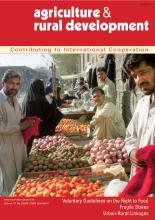Land Library
Welcome to the Land Portal Library. Explore our vast collection of open-access resources (over 74,000) including reports, journal articles, research papers, peer-reviewed publications, legal documents, videos and much more.
/ library resources
Showing items 451 through 459 of 463.Following unanimous approval of the Voluntary Guidelines (VGs) on the Right to Adequate Food by FAO member states, with civil society's broad support, the question of «next steps» arises.
Life without liberty would result in some or the other form of slavery.
Fragile states, posing a major challenge of our times, are increasingly becoming a focus of attention in international politics and development cooperation. But very often, the viewpoint of the people affected by fragile statehood is not sufficiently heard.
Until 1978, the Afghan state was weak but stable. In contrast, rural regulatory structures that complemented the state have always been strong.
Somalia is the longest known case in modern times of a country whose central state has ceased to exist for many years. Although Somalia is often said to be a country in chaos and anarchy, a new form of social organization emerged here some time ago.
After ten years of civil war in which grave human rights violations and atrocities were committed, especially against women and children, Sierra Leone was regarded as a «failed state». A massive UN peacekeeping mission managed to demobilize the combatants in 2002 and peace was restored.
Afghanistan, Sierra Leone and Somalia: these three countries stand for different histories of a fragile state.The author of this article analyses different case studies to determine the various causes, such as the role of ethnic identities, claims to power by clans and other sub-state groups, or
Development policy has to deal with the full spectrum of fragility in developing countries, which can range from individual deficits, for example in guaranteeing security, to the total collapse of state structures.The scope available to development policy and other external actors is always limit
Urbanisation and economic transformation - the growth of non-farm, industrial and service sectors - offer many opportunities for improvements in poor people's lives.The crucial challenge is to ensure that places work better for people, providing an enabling and supporting environment for changing

